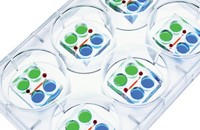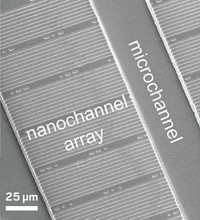Advertisement
Grab your lab coat. Let's get started
Welcome!
Welcome!
Create an account below to get 6 C&EN articles per month, receive newsletters and more - all free.
It seems this is your first time logging in online. Please enter the following information to continue.
As an ACS member you automatically get access to this site. All we need is few more details to create your reading experience.
Not you? Sign in with a different account.
Not you? Sign in with a different account.
ERROR 1
ERROR 1
ERROR 2
ERROR 2
ERROR 2
ERROR 2
ERROR 2
Password and Confirm password must match.
If you have an ACS member number, please enter it here so we can link this account to your membership. (optional)
ERROR 2
ACS values your privacy. By submitting your information, you are gaining access to C&EN and subscribing to our weekly newsletter. We use the information you provide to make your reading experience better, and we will never sell your data to third party members.
Analytical Chemistry
Microfluidic Device Synchronizes Bacteria
Cellular Analysis: Automated method produces bacterial populations in a single stage of the life cycle
by Erika Gebel
October 3, 2012

Left to their own devices, bacterial populations contain a mix of young, middle-aged, and old cells. But scientists studying events that occur at different parts of the microbes’ cell cycles learn more about each phase by studying populations all at the same stage. Researchers have now developed a microfluidic device that automatically syncs bacteria to the same stage for on-chip analysis (Anal. Chem., DOI: 10.1021/ac301565g).
The life cycle of the freshwater bacterium Caulobacter crescentus contains two morphologically different cell types: a sticky immobile stalked cell that divides to release a mobile flagellated cell called a “swarmer.” Its two cell types make the bacterium “a good model system” to study bacterial cell cycles, says Stephen Jacobson of Indiana University, Bloomington. For instance, the swarmer cells adhere to surfaces where they become stalked cells and form a biofilm. But, Jacobson says, scientists don’t understand how the cells become stuck in the first place. “To study that process, it’s best to synchronize the cells,” he says.
The current method for synchronizing C. crescentus is called the plate-release technique, says Jacobson. Researchers grow the bacteria on a petri plate and then add buffer to pick up newborn swarmers. By collecting the buffer containing synchronized swarmers, the researchers leave older stalked cells stuck to the plate. The drawbacks of plate release, according to Jacobson, are that the process is labor intensive and that scientists can collect synchronized populations only for a day before the plate becomes overgrown. When that happens, Jacobson says, the buffer starts picking up stalked cells as well as swarmers, so the resulting sample contains a mix of cell types.
Jacobson and colleagues aimed to automate the production, collection, and analysis of synchronized cells using a microfluidic device containing a series of chambers. They started by pumping unsynchronized cells from an input chamber into a central serpentine chamber with a large surface area for stalked cells to latch onto. As the biofilm grew, the researchers prevented overgrowth by flushing the chamber every 15 minutes with media the microbes need for growing. After a day, they started collecting synchronized swarmers by pumping media into the chamber, allowing it to gather newborn cells for five minutes, and then sending the fluid into an analysis chamber.
Because the C. crescentus cells expressed green fluorescent protein, the researchers could follow the bacteria’s movement in the analysis chamber on the chip and thereby check their synchronization using a fluorescence microscope. They found that 89% of the cells captured by the fluid were swimming—synchronized swarmers. The team confirmed their results with an off-chip analysis using flow cytometry. This percentage is similar to that obtained by plate release, which was 87%. Unlike in plate release, the microfluidic device kept producing synchronized populations of cells for four days, after which the biofilm became overgrown.
Compared to plate release, Shuichi Takayama of the University of Michigan, Ann Arbor, says, “They can sample more frequently, use less cells, and less material.” As a result, scientists can study synchronized cells more easily and cheaply. Jacobson is planning experiments that probe the formation of bacterial biofilms. He says the device should work with any cell type that, in one phase of its life, sticks to the device’s walls naturally--or that can be made to adhere.




Join the conversation
Contact the reporter
Submit a Letter to the Editor for publication
Engage with us on Twitter